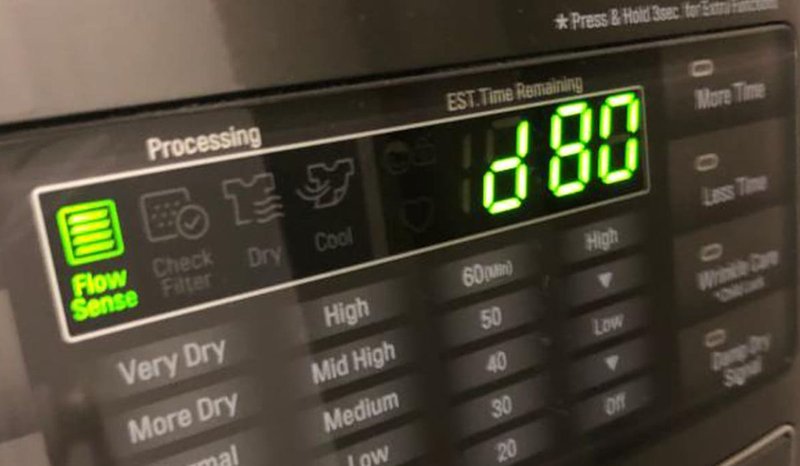
Here’s the deal: modern dryers, like those from LG, are packed with smart technology. They can practically think for themselves, but they also have their quirks. When the “HE” error pops up, it might mean something simple, like a blocked vent or faulty sensor, or it could point to a more complex problem like a failing thermostat or burnt-out heating element. The trick is knowing when you can fix it yourself and when it’s best to call in the pros. Let’s dig deeper into understanding what really goes on with the “HE” error and the signs that you might need a technician.
Understanding the “HE” Error Code on LG Dryers
Alright, let’s break this down. The “HE” error code lights up when your LG dryer detects a snag in its heating capabilities. In plain English, it’s like trying to dry clothes on a windy day without a hint of sun; it just doesn’t work. Usually, this error is a signal from your dryer that it’s struggling to generate or maintain the right level of heat. You might even notice your clothes are damp or cold, even after a full drying cycle.
This error can happen for a variety of reasons. It could be as simple as a lint trap that’s chock-full, blocking the airflow, or a more technical issue, like a defective thermostat. Think of the lint trap as the gateway to your dryer’s lungs. If it’s clogged, the whole system can’t breathe properly, which affects the heat. In some cases, the error could be due to external factors, like the power supply, or internal issues, such as a faulty heating element.
The first step is identifying if it’s a minor roadblock you can clear or a major overhaul that requires technical expertise. Sometimes, all you need is a good clean-up. However, if you’ve checked the basics and the error persists, it might be time to consider calling in a professional.
Common Causes of the “HE” Error Code
You might be wondering, what exactly causes this pesky error code to show up? Well, let’s explore some common culprits that could be at play. One usual suspect is a clogged vent. The vent is like your dryer’s exhaust pipe. If it’s blocked, heat gets trapped inside, leading your machine to cry out for help with an “HE” error. Think of it like how a kinks in a straw can make drinking difficult — your dryer struggles to “breathe” properly.
Another possible cause is a faulty thermostat, which is like the temperature gauge in your car. If it’s not working right, your dryer could either overheat or not heat up at all. This imbalance can trigger the error code, indicating that the heat can’t be properly controlled. Checking if the thermostat is functioning correctly might not be a beginner’s task, but recognizing its importance in the heating process is key.
Lastly, a burned-out heating element can be a real problem. The heating element is the heart of the dryer’s heating function, and if it’s damaged, it won’t generate the heat needed to dry clothes. This issue often requires a pro’s touch as it involves disassembling and repairing internal components. If your dryer is frequently showing this error, and simple fixes haven’t worked, the heating element might be the culprit.
When to DIY and When to Call a Technician
So, you’ve got the “HE” error flashing, and it’s time to decide: roll up your sleeves, or reach for the phone? Start by tackling some DIY basics. Check your dryer’s lint trap and venting system. Give them a good clean to ensure nothing’s blocking the airflow. Sometimes, a clean sweep is all it takes to restore order. It’s a bit like straightening out a tangled garden hose — suddenly, everything flows better.
If the problem persists, look for more subtle signs. Is the dryer making unusual noises, or do you notice burning smells? If so, it’s time to call in the cavalry. A professional technician has the tools and expertise to diagnose deeper issues — things like electrical faults or intricate component failures that could be causing the error.
Remember, tackling complex repairs without the right knowledge can lead to more damage, like trying to change your car’s oil without understanding the engine. If you’re uncomfortable with electrical repairs or suspect a more serious issue, seeking professional help can prevent further damage and ensure your dryer is safe and functioning.
Preventing Future “HE” Errors
Avoiding that dreaded “HE” error in the future doesn’t have to be a Herculean task. With a few preventative measures, you can keep your dryer running smoothly. Regular maintenance, like cleaning the lint filter after every use, ensures that airflow remains unobstructed. It’s like brushing your teeth to prevent cavities — a simple habit that prevents bigger issues.
Additionally, make it a point to check the dryer vent system every few months. Clear out any lint or debris that might have built up over time. This not only helps in maintaining effective heating but also enhances your dryer’s efficiency, saving you energy and reducing drying times.
Lastly, keep an eye on your machine’s performance. If you notice it’s taking longer to dry clothes or if the error frequently pops up, it might be time for a professional check-up. Think of it as a regular health checkup for your dryer — catching problems early can save you from bigger headaches down the road.
By following these tips, you can extend the lifespan of your dryer and avoid that pesky “HE” error. However, whenever in doubt, don’t hesitate to reach out to a technician to keep your machine in top-notch condition.